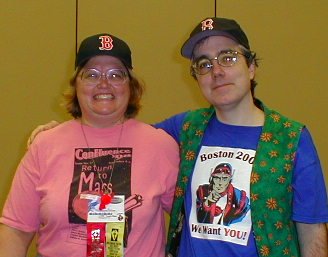Some people – especially, I suspect, those who don’t read widely – like to talk about the dichotomy between “literary fiction” and “popular fiction,” between books that value style and those that are page turners, between, let’s say, James Joyce and Tom Clancy, or, in the SF world, between John Crowley and Robert Heinlein. But this ignores the fact that many good novels can be both very well written, in style where the writing is part of the impact, and at the same time be exciting page turners. (And this also of course ignore the fact that, while Joyce’s
Ulysses isn’t a page turner in the sense of wanting to rush through to see what happens next, it is compulsive reading, at least once you know what Joyce is trying to do and where he’s heading. But I digress.) To be fair, part of the reason for this apparent dichotomy is that you often use different reading protocols for books at opposite ends of this spectrum. For books where the style is important, most readers slow down, to absorb and enjoy the writing. For page turners, the temptation is at times to skip over words, moving rapidly ahead to find out what happens.
But there are many books in which you’re pulled both ways. Christopher Priest’s
The Prestigeis a great example.
The Prestige centers around the story of two stage magicians in the late 1800s – Alfred Borden and Rupert Angier. In fact, the book is told through their journals, and through the journals of two of their descendents, living in our time. The two men are rivals, a rivalry which starts when Borden, discovering that Angier is making money as a spiritualist, tries to expose him. The two men’s careers are then spotted with attempts by one another to expose or sabotage what the other is doing, sometimes in dangerous fashion. At the same time, the rivalry drives each to develop new and more elaborate acts. Both men want to end the rivalry, as both come to feel that it is wrong, but neither knows how to end it.
Priest’s use of the journals of the two men as the core of the book (with the journals of the two descendents as a more modern frame) adds to the effect by giving us each man’s point of view of what is going on, though it also causes us to doubt, at times, the truth of what we’re being told. We first, of the two, see things from Borden’s point of view, and sympathize with him. He did indeed sabotage Angier’s séance. But he was doing it because he believed that it was breaking the implicit bond between the illusionist and his audience, the traditional magician’s view that the illusionist doesn’t claim magical powers, that he and the audience know, deep down, that all is an illusion. But in thinking of what he saw in the séance, he becomes convinced that it did comfort the family, so he writes a note of apology, which Angier ignores. At this point, we’re convinced that Angier is a young upstart, who doesn’t respect tradition, and who stubbornly carries on a feud over what is really a trifle.
But the picture changes when we look at it from Angier’s point of view. He is a young struggling magician when we first meet him, not the arrogant young man Borden views him as. Séance’s are a way to stay afloat and to provide for the baby that is on the way. Borden’s exposure of his séance not only destroys the séance but causes Angier’s wife to miscarriage – hence Angier’s angry response. Priest explores Angier in more depth than any of this other characters; far more of the book is told from Angier’s journals than those of any of the other characters, and, while we feel that Angier is honest with us, we do see things from his point of view and come to like him. He means well – but of course the tragedy of the feud is so, in his way, does Borden. Neither man is a villain, even if at times each views the other as one.
Much of the story follows the careers of the two men. The behind the scenes look at stage magicians – how they work, how they interact their view of the world – is fascinating. Priest has done his research (in part, apparently, in alt.magic on Usenet). This immersion into the world of magic in the 19th century is both compelling and essential to the grounding of the story. Little touches – the ways the magicians name their illusions, the vocabulary of the stage, the way stages are set up for the show, even the way magicians phrase help-wanted ads – make this a well realized world. The novel, even when it takes a turn toward the fantastic, is soundly grounded in realism. And it does take a turn toward the fantastic when Angier, desperate to find a way to better Borden’s “New Transported Man” illusion, travels to America to visit Tesla, who at the time has a laboratory outside of Colorado Springs (though hints of what is going to happen here are present earlier in the story, since some parts of the story are told out of order).
This is a wonderful novel. It won the World Fantasy award, and is soon to be a motion picture starring Hugh Jackman as Angier, Chritian Bale as Borden and David Bowie as Tesla. I’m very much looking forward to the movie.

